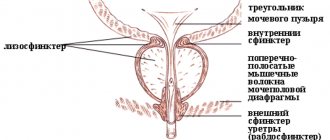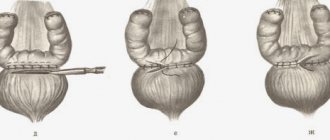Problems with urine leakage usually occur in men after prostate surgery or due to age-related weakening of the pelvic muscles. The situation is sometimes very serious indeed and requires surgical or medicinal correction. However, in most cases, the problem is successfully corrected by strengthening the pelvic muscles. Kegel exercises are useful for men not only for urinary incontinence, but also for improving the general condition of the genitourinary system. You can perform them anywhere - at home, in an office chair, or while standing in line.
In what cases will Kegel gymnastics help?
Kegel originally developed his pelvic muscle training system for people suffering from varying degrees of urinary incontinence. Later, these exercises began to be used to control orgasm and ejaculation, as well as to improve erectile function and prevent prostatitis.
Kegel exercises are also suitable for prevention. It helps to avoid severe urinary incontinence after prostate surgery. In most cases, when an adenoma is removed, the fibers of the urethral sphincters are damaged, as a result of which urine begins to leak involuntarily. To minimize the severity of symptoms, urologists recommend that patients begin daily Kegel exercises a month before surgery as a preventative measure. Strong muscles will recover faster.
Muscles of the genitourinary diaphragm before, during and after regular exercise
Kegel exercises can help prevent urine leakage in the early stages of BPH. Trained muscles will be able to expel urine longer, preventing the accumulation of residual urine.
In men over 65 years of age, urine leakage may occur due to age-related atrophy of the pelvic muscles (pelvic floor incompetence), weakening of the bladder walls and urethral sphincters. Regularly performing Kegel exercises helps maintain the correct anatomical position of the genitourinary organs and improve their tone.
In some older men, weakness of the pelvic muscles and sphincters leads to not only urinary incontinence, but also fecal incontinence. Kegel exercises eliminate this problem and are also a good prevention of hemorrhoids.
If urinary incontinence is caused by nerve damage or disruption of the nerve centers that regulate urination, then pelvic muscle training may not be effective. In such cases, medication and specific physiotherapy are necessary.
Causes of urinary disorders
The reasons for the development of pathologies of the urinary system are very diverse - from hypothermia to malignant neoplasms. But also an increase in the frequency of urination is due to changes in the human body due to age.
More often, this problem manifests itself in patients with prolapse of the bladder, which is associated with a decrease in muscle tone. Weakening of the pelvic floor and bladder muscles provokes involuntary loss of urine with slight pressure and tension in the abdominal wall - when sneezing, laughing, coughing.
The causes of urinary incontinence of varying degrees, in addition to bladder disease, are other factors:
- complicated childbirth;
- consequences of cystitis;
- pyelonephritis;
- change in the physiological position of internal organs;
- menopause;
- excessive physical activity;
- hypothermia.
Also, after childbirth, the muscle tone of the urinary system may decrease. It takes some time for muscles to recover. You can speed up the process through special exercises and the use of medications.
How to do Kegel exercises for urinary incontinence
First you need to find and feel the leading muscle - the pubococcygeus (PC muscle). It is she who enhances the closing function of the urethra and participates in the formation of the posterior vesicourethral angle, which is an additional mechanism for urinary retention. To find it, it is enough to interrupt the process of urination or shake the erect penis. If you squeeze the PC muscle during an erection, the penis will twitch.
To feel the desired muscle more confidently, it is recommended to interrupt the stream of urine several times during each urination and hold the pause for a couple of seconds. When performing Kegel exercises, it is important to learn how to tense it in isolation, without involving the anal sphincter, buttocks, thighs and abdominal muscles. To check the work of the PC muscle, you can place your fingers on the area between the scrotum and anus during contractions. A twitching sensation should be felt.
Exercise Tips
For urinary incontinence in women, Kegel exercises at home give results only if the exercise is done correctly.
There are several conditions, the fulfillment of which will significantly improve the result:
- When performing exercises, the stomach should be as relaxed as possible.
- All muscles should tense at once: vaginal, anus, urethra and sciatic.
- It is important to monitor your breathing. It should be rhythmic and relaxed.
- After completing the complex, it is recommended to relax a little and walk around.
By performing simple exercises, you can seriously improve the condition of the internal pelvic muscles, cure urinary incontinence and increase a woman’s libido.
Execution technique
Before exercising, you must thoroughly empty your bladder. If urine leakage is severe and there is residual urine, then you can train using special absorbent pads, in the bath, or on the toilet. Otherwise, it will be impossible to fully concentrate on technology.
Kegel gymnastics is based on several basic exercises:
- Slow compression. Pull the muscle towards yourself for three counts, hold for a couple of seconds and also slowly relax for three counts.
- Pushing out. Make a pushing motion, as when squeezing out the remaining urine after urinating. Hold the position for 3 seconds and relax.
- Fast contractions without pauses.
- Gradual compression and relaxation (“lift”). At the first stage, the muscle is slowly and gradually pulled into itself. Before the end point of tension, you need to take 4-6 pauses of 2-4 seconds, then relax.
In the first 2-3 days, it is enough to perform 50 contractions of any kind, then their number increases to 150 or more. Breathing should be free. The more attention you pay to the working muscle, the better the effect.
The importance of additional exercises
It is advisable to perform Kegel exercises in combination with other exercises to develop the pelvic muscles. Deep plie squats with the pelvis pulled back are best suited. Long-term isolated training of the pubococcygeus muscle can lead to an anatomical shift of the genitourinary organs (the effect of a tucked pelvis).
Plie squat technique
Failure of the pelvic floor muscles in older men is expressed by a displacement of the sacrum forward, inside the pelvis. Because of this, the muscular “trampoline” that supports the genitourinary organs begins to sag (becomes a “hammock”). Kegel exercises in this case will lead to further convergence of the sacrum with the pubis and aggravation of the incontinence problem. A sure sign of pelvic floor incompetence is the absence of a curve in the lower back. Squats stretch the pelvic muscles, strengthening the “trampoline”. The effect of Kegel exercises can only be achieved if the gluteal muscles are strong enough.
About the exercises
The complex includes classes of different levels of severity. Start with the simplest ones and increase the load and duration of exercises over time. You will notice the first improvements after a month of hard training. For lasting results, six months of persistent work on yourself are required.
Exercise in a comfortable position: horizontally on your back, sitting or standing. Observe the number of exercises and monitor the execution time. Overstraining muscles does not lead to anything good. You will only make the situation worse. Empty your urine before every workout and minimize your fluid intake.
Next, we will analyze the initial exercises in order.
Compression
Imagine that you are trying to stop urination by squeezing your muscles. Do this slowly, holding for three seconds, then relax the muscles. Rest for three seconds and repeat the action. This should be done no more than ten times. After two workouts, you will already be increasing the time to five seconds.
Over time, you will hold your muscles for ten seconds. After a month of your efforts, you can safely squeeze your muscles for twenty seconds. At the same time, you should have up to thirty such workouts per week.
Once the first week of training has passed, you need to complicate the process. We squeeze the muscles as before for three seconds, after which we rest and squeeze for five seconds more tightly. Each time the compression should be stronger.
Flashing
You can perform flashing whenever and wherever you want. Quickly squeeze and relax the muscles you use to hold your urine. Whether you're sitting in your car, waiting for the traffic light to turn green, or working at your desk, remember to exercise and do it. Whether you are cleaning the house or preparing a meal, make reductions at the same time, and so on.
A set of Kegel exercises to strengthen the bladder muscles
An example of a Kegel exercise complex (perform 3-4 times a day):
- 50 quick squeezes to warm up;
- 10 phased lift reductions;
- 30 pushes;
- 10 slow compressions.
The principle of work is the same as in the gym: if you feel overworked, discomfort in the groin, then you can take a break for 1-2 days, reduce the number of approaches. If nothing is felt, then the number of contractions and approaches can be increased.
As you master the basic technique, you can perform Kegel exercises not only while sitting or standing.
Recommended poses:
- Lying on your back with your legs bent and slightly apart.
- Lying on your stomach, one leg bent at the knee.
- On all fours with emphasis on the elbows.
- Sitting on the floor with crossed legs (lotus position).
- Standing, feet wider than shoulders, slightly lean forward, hands on the front of the thigh just above the knee.
To enhance the effect, you can combine exercises with breathing exercises. As you inhale, tense the muscle, slightly bend your pelvis forward, while exhaling, relax it, and move your pelvis back. The first results from performing the exercises will be noticeable after 3-4 weeks.
Standard workouts
Let's consider the simplest activities that almost all women can perform in the absence of contraindications:
- lie in a horizontal position on your back so that you are comfortable. Spread your legs and relax. Start tensing and relaxing the muscles of the intimate organs about thirty times, don’t rush. We increase the number of actions to 10-15 every day. As a result, you will have to do 200-300 contractions;
- get on all fours. Place your hands connected in front of you, place your head on them, pull your muscles inward and upward;
- lie on the mat in a horizontal position on your stomach and bend your leg, moving it slightly to the side. You should alternately tense and relax your muscles for at least a minute;
- lie on your back and bend your knees, slightly moving them to the sides. Make sure your feet don't leave the floor. Place one hand on your stomach and the other under your buttocks. Alternately tighten and relax your pelvis;
- Sit cross-legged, like in the lotus position. Keep your back straight, tighten your intimate muscles as if pushing off the floor;
- Place your feet shoulder-width apart and bend your knees slightly. The back is straight. Tighten and squeeze the pelvic muscles, then gradually relax.
Applications
To make it easier for men and make the process more interesting, several smartphone applications have been released. They will help you monitor the regularity of classes and create a program. Time is calculated automatically, so you can fully concentrate on the sensations. As the muscles strengthen, the practitioner masters level by level. You can chat on the built-in forum and share your successes.
Application examples:
- Kegel Muscle Exerciser (https://play.google.com/store/apps/details?id=com.workout.kegel&hl=ru);
- Kegel Trainer (https://play.google.com/store/apps/details?id=tmanchuk.com.prostatitis);
- Kegel trainer (https://play.google.com/store/apps/details?id=com.jsdev.pfei&hl=ru).
Screenshots of applications for training the PC muscle
To diversify your workouts, you can purchase a special simulator for performing Kegel exercises - Private Gym. The kit includes a disk with a description of the training program designed for 2 months, magnetic weights for the penis. The simulator costs 7,500 rubles. You can buy it here: https://extender24.ru/product/trenazhyor-kegelya-private-gym/.
Basic Rules
Kegel exercises for women with incontinence should not be performed on a full stomach. There should be at least 1.5 hours between the start of class and eating. It is also important to empty your bladder before starting your workout. While performing the exercises, maintain even breathing. Don't hold your breath in and out. It is also important to use only the necessary muscles, without helping yourself with the abdominal muscles or buttocks.
Kegel exercises for prolapse of the uterus and for its contraction after childbirth
To get started, just a few minutes of exercise is enough to repeat three times a day. Once you have gained certain skills, it is recommended to devote up to half an hour to the exercises every day, performing 30 repetitions of each movement. Exercise regularly, as acquired skills can quickly be lost and muscles lose strength.
You need to start the lesson smoothly. Take your time and do not let the exercises lead to pain or increased urinary problems. Start with five repetitions of each exercise, and increase the number by another five each week, gradually achieving the required thirty repetitions.
Kegel exercises include three main muscle movements:
- Compression . Assume static tension of the muscle group involved in controlled cessation of urination. Abbreviations. They involve pulsating muscle movements - alternating compression and relaxation.
- Ejections . Their essence is alternate tension of the pelvic muscles, aimed either at compression or at pushing, as if during childbirth or defecation.
Indications, contraindications, side effects
Types of urinary incontinence for which Kegel exercises are indicated:
- Stressful, caused by insufficiency of the pelvic floor muscles and sphincters. Occurs during coughing, running, sneezing.
- From bladder overflow with relative insufficiency of sphincters.
- Postoperative.
It happens that Kegel exercises not only do not save a man from urine leakage, but, on the contrary, create problems for him. The cause may be overtraining, starting classes too early after surgery, or hidden infections.
Contraindications:
- Active inflammatory processes in the organs of the genitourinary system.
- Pain and bleeding after surgery. After TUR and other types of prostate surgery, the start time of exercise must be agreed with your doctor.
- Stones and cysts in the prostate.
- Malignant neoplasms in the pelvic area.
Men who regularly perform Kegel exercises may experience nagging pain in the testicles or prostate. Exercises should be temporarily stopped so as not to provoke inflammation. Perhaps due to the stimulation of blood flow, the “dormant” infection was activated. To check, it is better to have prostate secretions analyzed (bacterial culture, PCR).
In some men suffering from chronic prostatitis, Kegel exercises persistently provoke an exacerbation. In such cases, you need to stop exercising and try to strengthen the immune system of the gland with the help of peptide drugs: “Prostatilen”, “Prostacor”.
The drug “Prostatilen” is intended for the treatment and prevention of prostatitis. Price in Russian pharmacies from 318 rubles.
Doing Kegel exercises too hard can lead to decreased potency. To eliminate symptoms, you need to take a break for a week.
What mistakes do beginners make?
It is clear that the exercises must be performed correctly. Without this you will achieve nothing. Many ladies make unacceptable mistakes in their desire to fix the problem as quickly as possible. All the work will go down the drain. Remember this.
The most common mistakes:
- air retention and abdominal retraction;
- uncomfortable posture;
- ignoring the occurrence of pain in the pelvis;
- lack of full breaks;
- heavy loads from the first day;
- huge breaks between workouts (more than 2 days).
If you experience pain or any discomfort during exercise, you should consult a specialist. Ideally, you should feel slightly tired after training. In order not to lead to serious consequences, pain should never be ignored.
Systematic work on yourself will provide you with relief within a month and a half. Many of the exercises can be performed anywhere and at any time, and others will not notice anything.
Useful nuances
- Start doing Kegel exercises for men - while urinating, this is how you visualize working the muscles.
- Take your time and do everything carefully: do not try to jump from stage to stage.
- Do not overstrain your pelvic floor muscles - it may have the opposite effect. After Kegel exercises, the muscles should simply be felt without causing a trace of pain or fatigue. There may also be some feeling of tension.
- If, after a set of tasks, uncharacteristic sensations or discharge appeared, an illness could be lurking in the body, which entered the active phase against the backdrop of a rush of blood to the pelvic muscles.
The Arnold Kegel complex seems too simple to work on the problem of urinary incontinence. This is a deceptive feeling; once you start them, it will immediately become clear. The realization will come very quickly that it is not for nothing that these exercises have been in demand for more than 60 years.
What is the point of exercise?
Urination is a controlled process for which the pelvic floor muscles are responsible. Their weakening and problems with the sphincter are one of the reasons for urine incontinence or its “leaking” after a “small” vomiting.
Arnold Kegel exercises are aimed at restoring and strengthening intimate muscles, which allows you to regain control over urination. It is important that these exercises help you return to a full life after surgery to remove the prostate.
The complex tasks are very simple, do not require special equipment or significant time investment: almost any man can do them.
We also have free video tutorials on how to enlarge your friend!
How does gymnastics work after surgery?
After surgery to remove the prostate gland, side effects may occur:
- urinary incontinence;
- weakening of erection and potency;
- frequent urge to urinate;
- discomfort after emptying the bladder.
Kegel exercises for men after prostate removal will help cope with these phenomena, as well as improve the elasticity of blood vessels and avoid blood stagnation.
This complex is aimed at strengthening the pubococcygeus muscle (PC muscle), which is responsible for the condition of the genitourinary system. It helps control the process of urination and bowel movements.
Exercises for urinary continence in men help:
- control the process of urination (avoid stagnation of urine, fight incontinence);
- restore potency.
Complications after prostate surgery
Adenomectomy, prostatectomy and other surgical procedures on the prostate gland can cause complications, the most common of which are:
- urinary retention - occurs due to incorrect manipulations of the operating doctor (for example, incomplete removal of hyperplastic tissue), pathological changes that occurred in the bladder muscle long before the operation, or swelling of the urethral mucosa. Much less often, a delay can be caused by a blood clot accidentally entering the urethra, or by postoperative swelling of the prostate;
- Urinary incontinence (stress or constant) - occurs due to damage to the sphincter and weakness of the muscle tissue of the bladder with a probability of 0.5-2%. Provided that doctors' recommendations are followed, within 2-3 months, in the majority of those operated on, enuresis goes away without additional treatment;
- massive bleeding , the development of which is possible during the operation or immediately after its completion with a probability of 2.5%. The solution to the problem is bladder tamponade, and in case of severe blood loss, blood transfusion;
- infection of the genitourinary system by bacteria of different types . It can occur during surgery or during the rehabilitation period, if the person operated on refuses to take medications, for example, antibiotics. The likelihood of infectious and inflammatory complications among patients who have undergone adenomectomy or transurethral resection varies between 2-20%;
- retrograde ejaculation - due to changes in the neck of the bladder, a significant part of the sperm moves into it during each ejaculation, which can lead to male infertility. The probability of this problem occurring is approximately 70%;
- erectile dysfunction and impotence. It can be observed due to the psycho-emotional state of the man who underwent surgery, or due to the fault of the surgeon who made a mistake during the intervention.
Depending on the general health of the patient, the stage of the disease, the choice of treatment and the professionalism of the operating surgeon, the likelihood of complications of a different nature depends.










